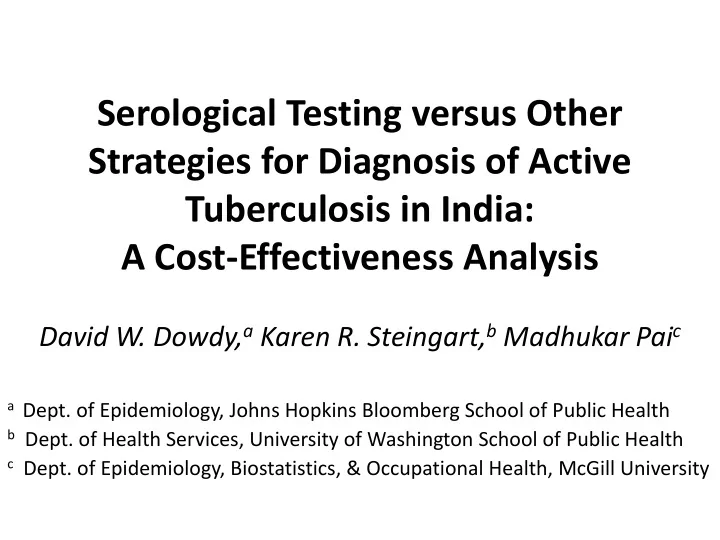

Serological Testing versus Other Strategies for Diagnosis of Active Tuberculosis in India: A Cost-Effectiveness Analysis David W. Dowdy, a Karen R. Steingart, b Madhukar Pai c a Dept. of Epidemiology, Johns Hopkins Bloomberg School of Public Health b Dept. of Health Services, University of Washington School of Public Health c Dept. of Epidemiology, Biostatistics, & Occupational Health, McGill University
Background: TB Diagnosis in India • 2 million cases of active TB per year in India – 39% of cases go undiagnosed. • WHO-recommended diagnostic s include sputum smear microscopy and TB culture. – Sputum smear: Cheap, but low sensitivity – TB culture: Expensive, slow, but high sensitivity • Serological testing is widely available through the private sector. – Cost-effectiveness of serological testing uncertain WHO, Global Tuberculosis Control. Geneva: WHO, 2009. Grenier J et al. Widespread use of serological tests for tuberculosis. Eur Respir J, in press.
Serological Testing for TB • Based on detection of TB antibodies in serum – Should not be specific for active (vs. latent) TB • Not approved for use in the U.S. or Europe – Often produced in Europe for export to countries where regulatory framework is weaker. • Quality of supporting evidence is very poor. – Small studies, industry-funded, hand-selected populations, inconsistent results – No randomized data Steingart K et al. Commercial serological tests for the diagnosis of TB. PLoS Med, in press. Grenier J et al. Widespread use of serological tests for tuberculosis. Eur Respir J, in press.
Methods • Decision-analytic cost-effectiveness model • Two analyses: – Analysis I: Smear vs. serology as initial test – Analysis II: Serology vs. culture as add-on to smear • Population: 1.5 million TB suspects in India – Current annual volume of TB serological tests – 10-15% of total TB suspects in India
No TB Test Sputum Smear Serology Smear + MGIT Survive Smear+ Die HIV + Survive Serology + Die TB suspect Smear- Die Serology - TB+ Survive Survive Smear+ Die HIV - Survive Serology + Die Smear- Die Serology - Smear + Serology Survive Survive Smear + Die HIV + Survive Serology + Die Smear - Survive Serology - TB- Die Survive Smear+ Die HIV - Survive Serology + Die Smear- Die Serology - Survive
Key Assumptions Parameter Value Sensitivity/Specificity: Sputum smear 0.53/0.97 Serology 0.68/0.87 TB Culture 0.87/0.99 Time to diagnosis: Smear or Serology 1 week TB Culture 8 weeks Cost: Sputum smear x2 $3.62 Serology or TB Culture $20 Prevalence of TB Among TB Suspects 14% Cost to Treat One TB Case $82
Cost-Effectiveness Diagnostic Test Cost (US$) Additional Additional DALYs Incremental TB Cases Averted False- Cost per Positives DALY Averted Performed Alone, Relative to No Microbiological Testing $11.9 million 44,000 36,000 623,000 $19 Sputum smear microscopy Serology $47.5 million 58,000 157,000 520,000 (dominated) Performed on Smear-Negative Specimens Only, Relative to Sputum Smear Alone TB culture $27.6 million 26,000 12,000 130,000 $213 Serology $39.0 million 24,000 152,000 110,000 (dominated) DALY = disability-adjusted life year; dominated = more costly and less effective
Sensitivity Analysis: Smear vs. Serology
Sensitivity Analysis: TB Culture vs. Serology
Discussion • Sputum smear is preferred to serology as an initial test. • TB culture is preferred to serology as an “add- on” test to sputum smear. • This is true despite conducting an analysis that is the “best-case scenario” for serology. – Published estimates overestimate actual accuracy. – Minimal “cost” for false-positives – High TB prevalence biases in favor of serology.
Limitations • Unable to adopt societal perspective • No accounting for drug resistance testing • Urban population with access to serology not representative of entire Indian population • Does not fully account for secondary TB transmission
Conclusions These data were presented to the WHO Expert Group on TB Serodiagnosis (Geneva, 2010). Strategic & Technical Advisory Group on TB and WHO have factored these data into their recent decision to make a negative recommendation on serological tests for TB (July 19, 2011)
Recommend
More recommend